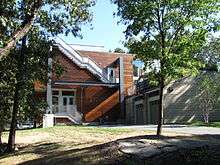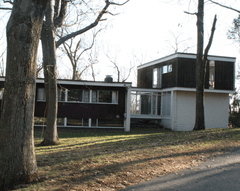Six Moon Hill
|
Six Moon Hill Historic District | |
|
Six Moon Hill house, designed by Norman Fletcher | |
  | |
| Location | 4, 8 Bird Hill & 1-40 Moon Hill Rds, 16, 24 Swan Ln., Lexington, Massachusetts |
|---|---|
| Coordinates | 42°25′23″N 71°12′42″W / 42.42306°N 71.21167°WCoordinates: 42°25′23″N 71°12′42″W / 42.42306°N 71.21167°W |
| Architect | The Architects' Collaborative |
| Architectural style | Modern |
| NRHP Reference # | 15000981[1] |
| Added to NRHP | January 19, 2016 |

Six Moon Hill is a residential neighborhood that was designed by The Architects' Collaborative (TAC) and is located in Lexington, Massachusetts. It consists of a collection of Modern houses on Moon Hill Road and neighboring streets in eastern Lexington, designed and built between 1948 and 1950. The area was listed on the National Register of Historic Places in 2016.
Description
With a focus on collaboration rather than individualism, the TAC approach was applied to all aspects of the community: design, development, construction, and operation. TAC established a nonprofit corporation and bought 20 acres (81,000 m2) on which to build, which was divided into 29 equally-priced lots of about one-half-acre each. Original house costs were between $10,000 and $22,000.[2] The first houses were designed and built in a modernistic way. The method of design was rectangular, flat-roofed, timber-sided homes, which was typical for residences designed by TAC. The houses are situated on a sloping hill lining a small road that forms a cul-de-sac.
Six Moon Hill runs as a consensus-based, collective community in which each member family pays dues and holds two voting shares. Among the original architects (and residents) were Benjamin C. Thompson, Norman C. Fletcher, Jean B. Fletcher, John C. Harkness, Sarah P. Harkness, Robert S. McMillan, Louis A. McMillen, and Richard S. Morehouse. Other notable residents included Nobel chemist Konrad Bloch, Nobel physicist Samuel C.C. Ting, Dr. Thomas C. Chalmers (past president of the Mount Sinai Medical Center), Wallace E. Howell (New York City's first official "rainmaker"), Robert Newman, (co-founder of Bolt Beranek and Newman), and John C. Sheehan (the first chemist to synthesize penicillin). Art historian Simon Schama lived on Moon Hill between 1981 and 1993, and described it as "a great place for kids and historians" in a 2010 interview with the Times of London.
Early years
In 1948, a group of TAC architects were looking to move from their rented lodgings in Cambridge and had the idea of building their own community. They found the land in Lexington during a Sunday ski outing. It was purchased from an auto dealer of the Moon Motor Car, and the project was given the name "Six Moon Hill", a nod to the six automobiles found in a barn on the property. It turned out that one of the cars was a Franklin, but they liked the original name too much to change it.[3]
In building Six Moon Hill, the goal was not only to build the houses but also to establish an ideal community. Norman Fletcher, one of the founders of TAC and Six Moon Hill, described the young architects as having been influenced in their ideas by "utopianism and socialism". The egalitarianism of the neighborhood also reflected the philosophy of Walter Gropius and TAC. All members of TAC including Gropius had equal shares, and he insisted that he not be looked at as the president.[4] Of the original TAC founders, only Gropius did not have a house on Moon Hill, having already built his house (Gropius House) in Lincoln, Massachusetts.
Recent years

The newest house is dubbed the "Big Dig House", as it is built from remnant construction material used in the Big Dig, a major highway tunnel project in Boston. Owner Paul Pedini (a vice president at the Big Dig's biggest contractor, Modern Continental) envisioned the house as a conglomerate of such material as concrete roadway decking and spare rebar. Designed by the Boston firm, Single Speed Design, the house is noted for being environmentally friendly and energy-efficient, and won a Metropolis award for innovative design.
See also
References
- ↑ National Park Service (2008-04-15). "National Register Information System". National Register of Historic Places. National Park Service.
- ↑ Architectural Forum, 1950
- ↑ Campbell, Robert. "Utopia Revisited Built by Architects Seeking a Model for Community Life, Six Moon Hill has Thrived for 45 Years." Boston Globe (pre-1997 Fulltext): 0. Apr 07 1994. ProQuest. Web. 29 Dec. 2014
- ↑ Norman Fletcher interview in Perry Neubauer, "Still Standing: Conversations with Three Founding Partners of the Architects Collaborative", 2007 (DVD)
- "Sarah Pillsbury Harkness: Homemade Modernism," Progressive Architecture, July 1995, v76, p77.
- Strutt, Rachel, "Was Six Moon Hill a Success?", The Boston Globe, October 31 2004.
- Flint, Anthony, "He could call it his Big Digs: Contracting firm's vice president aims to turn project leftovers into main course, his Lexington home," The Boston Globe, April 25, 2004.
- “Six Moon Hill”. Architectural Forum, June 1950, v92, no. 6, pp. 113–123.
External links
- Historic Survey of Six Moon Hill at lexingtonma.gov
- ModernMass.com - A brief history of modernist neighborhoods and houses in Lexington and Boston's western suburbs from a realtor's perspective
